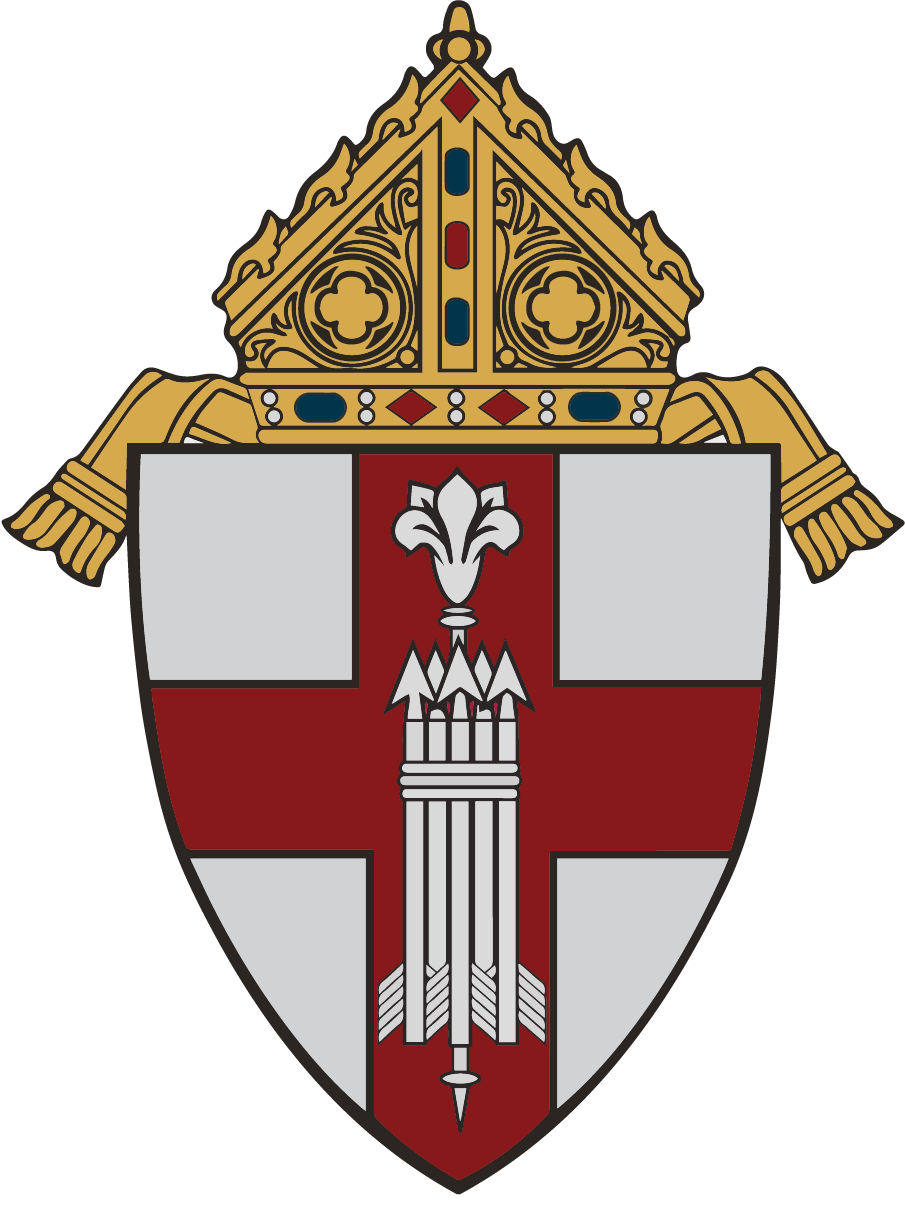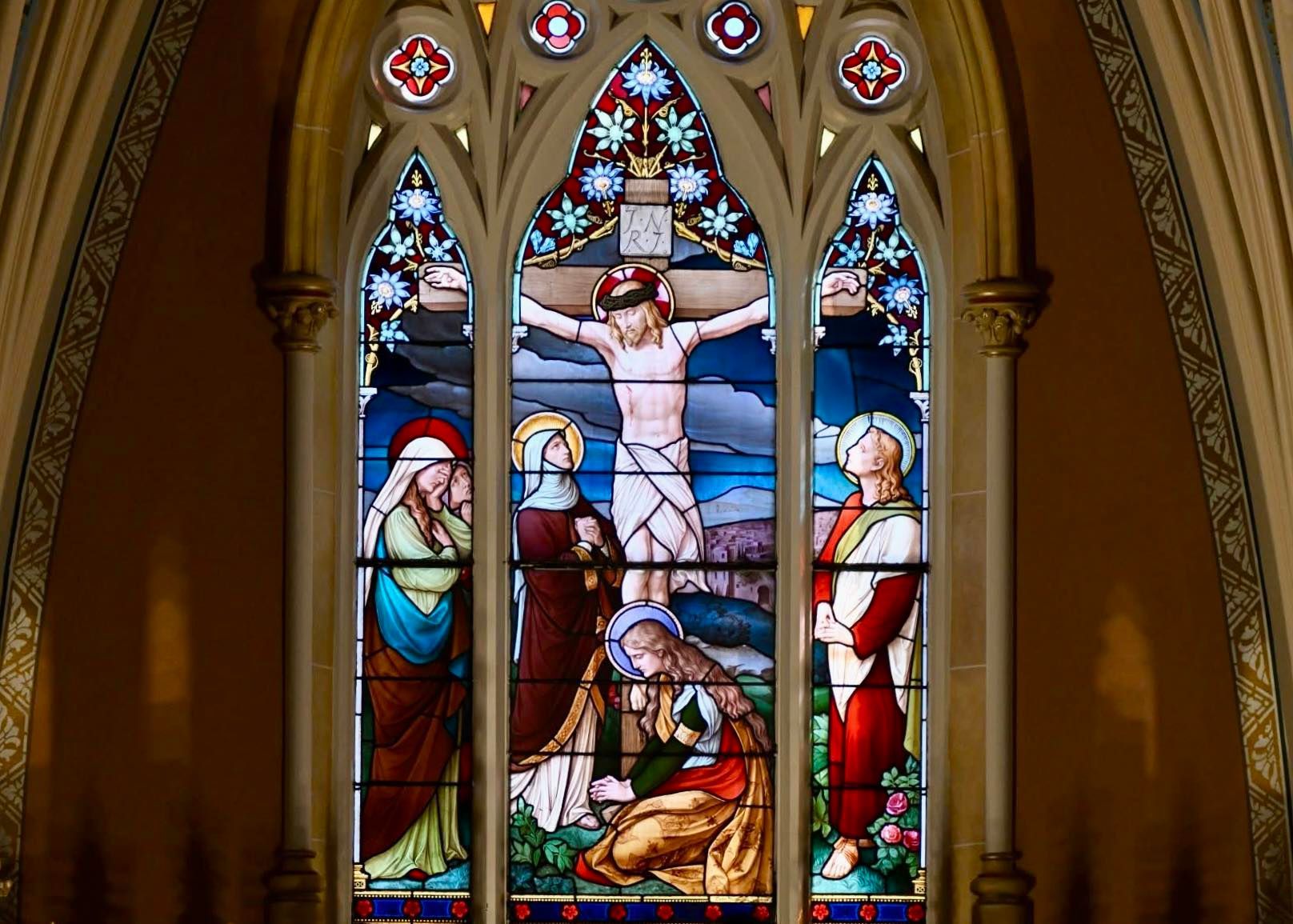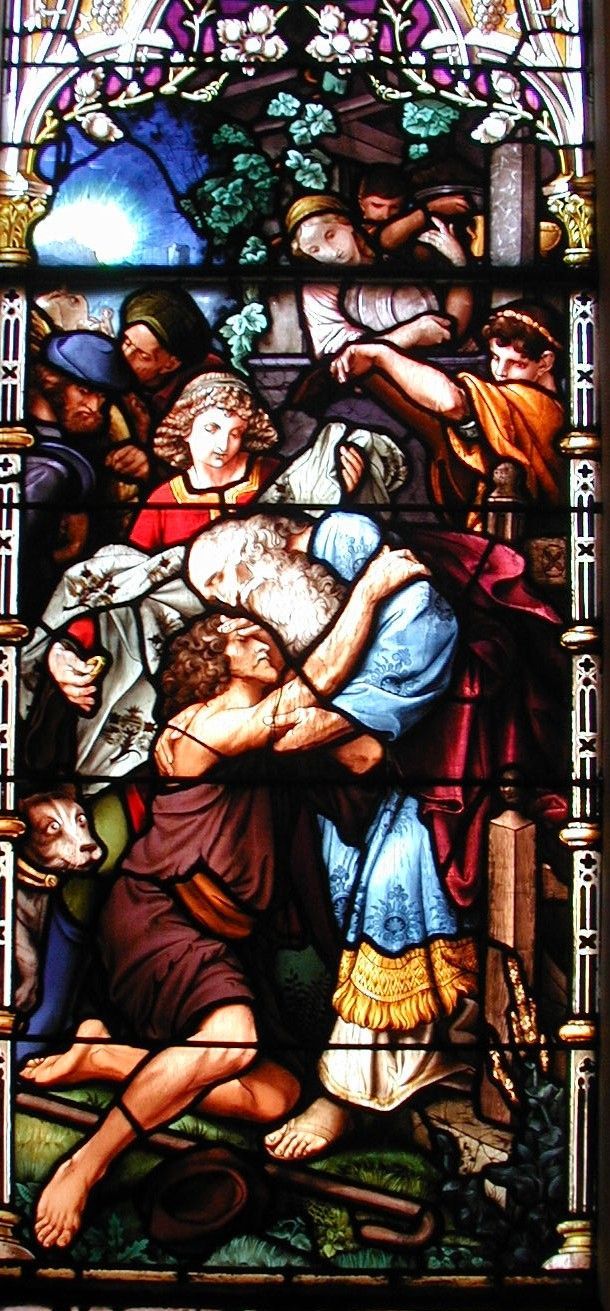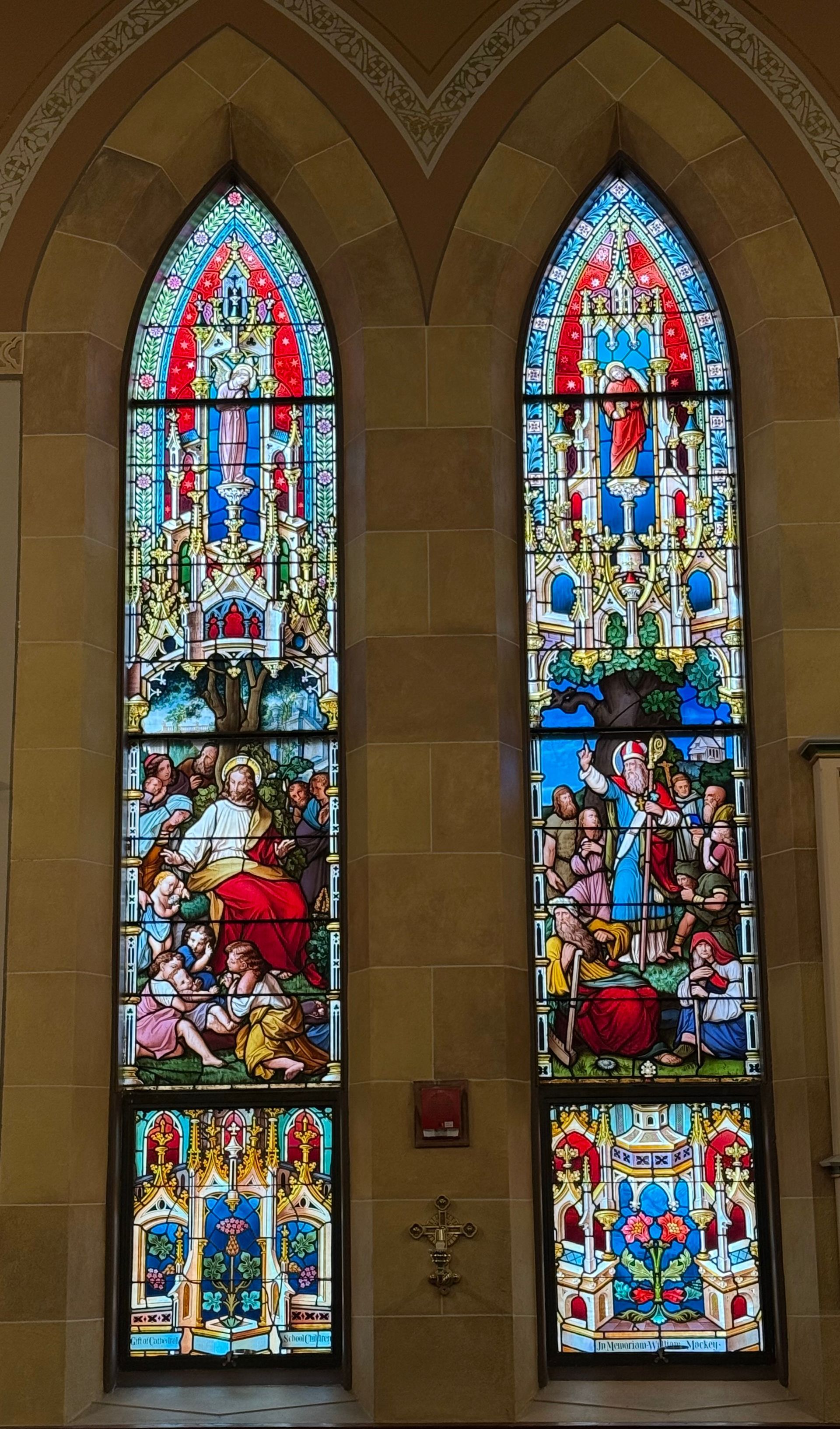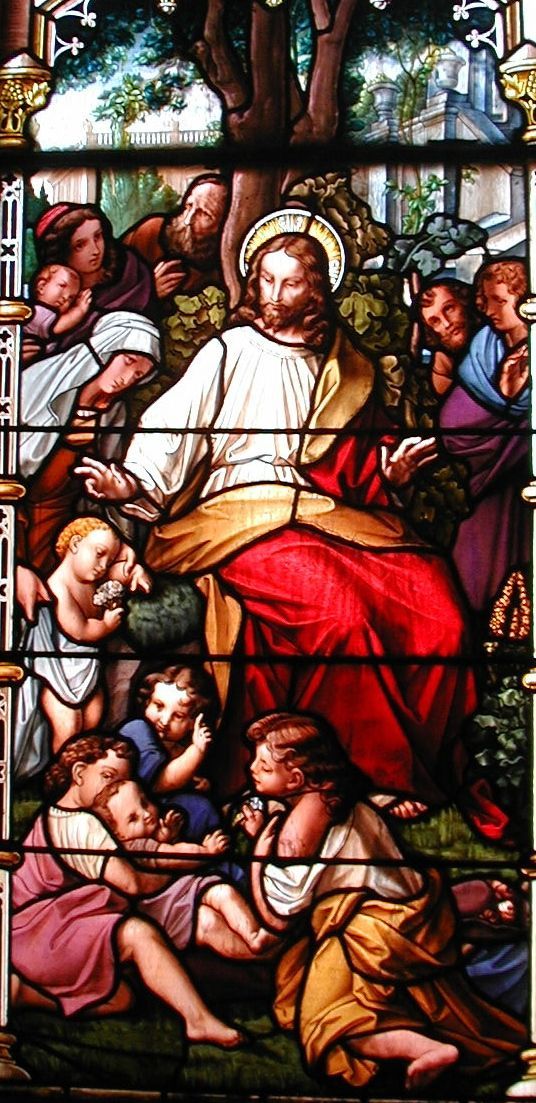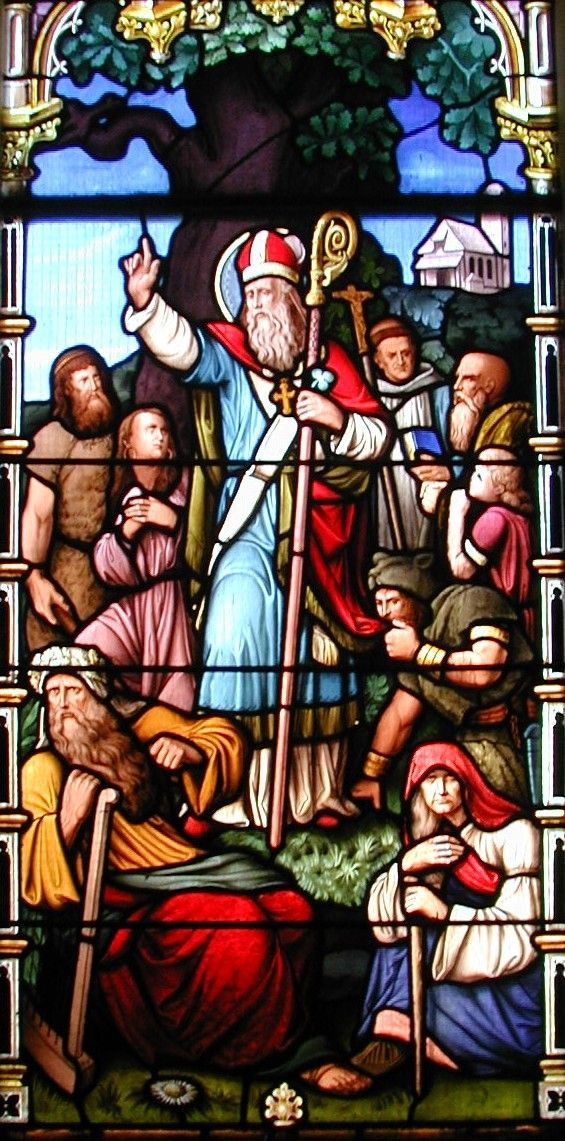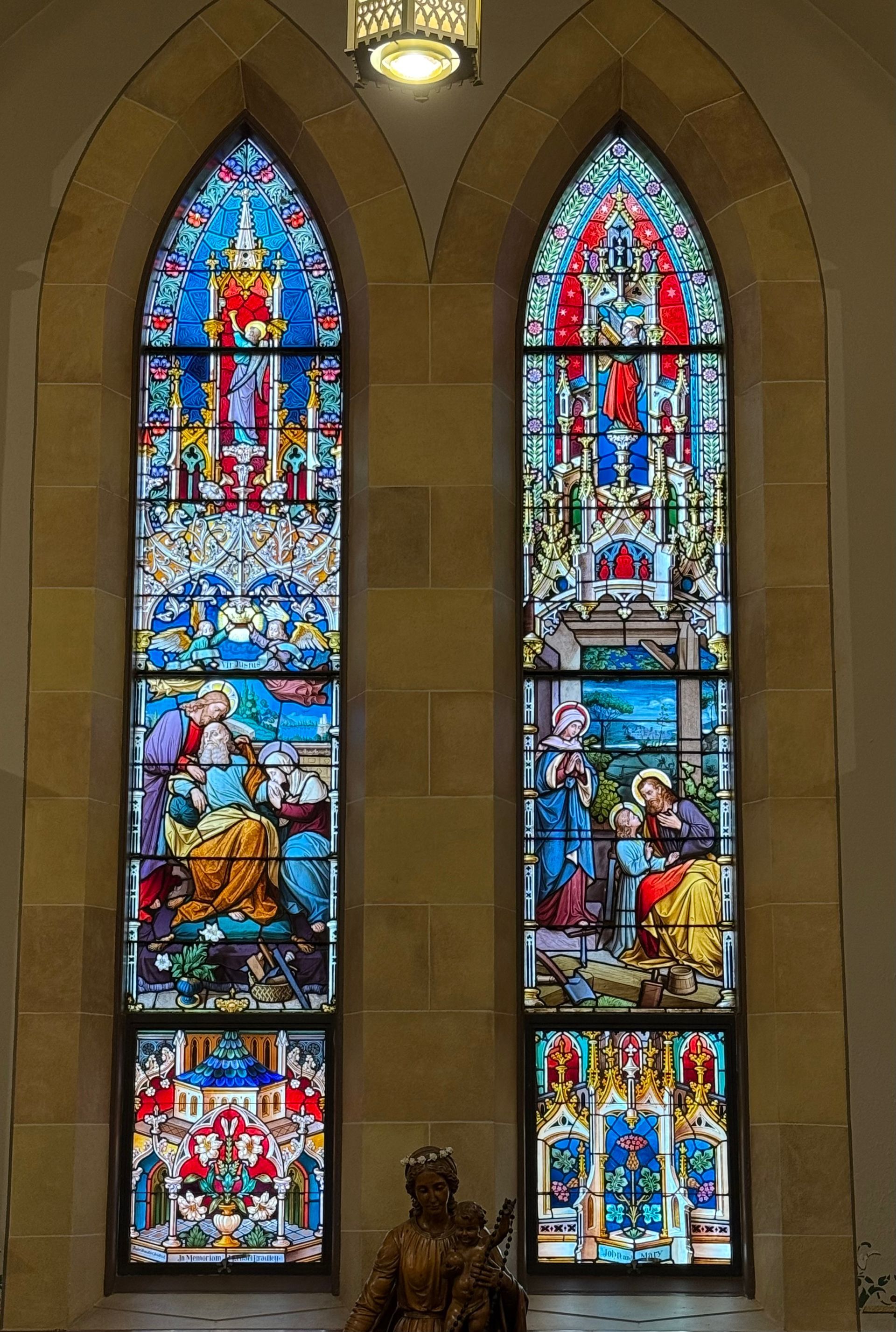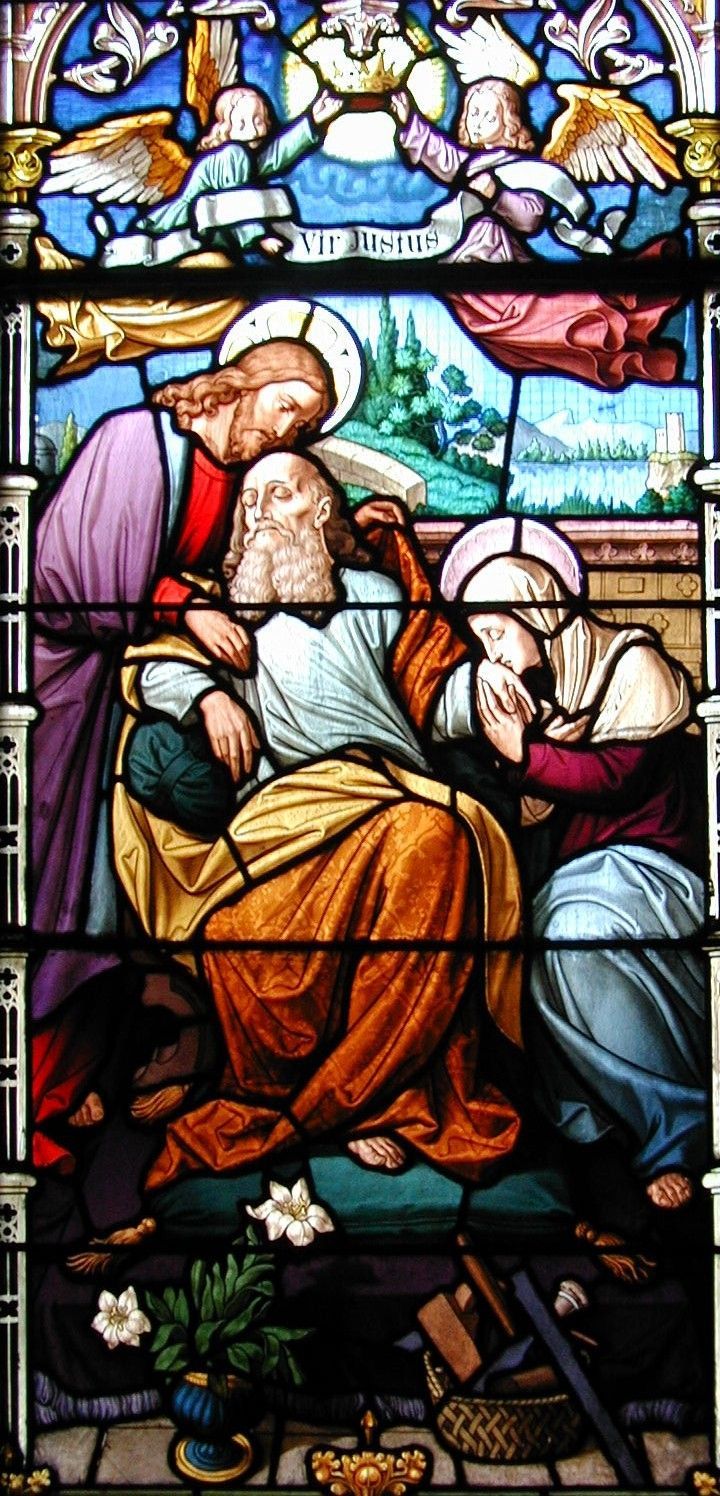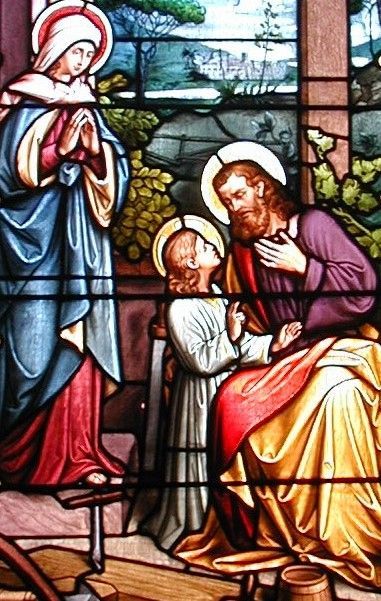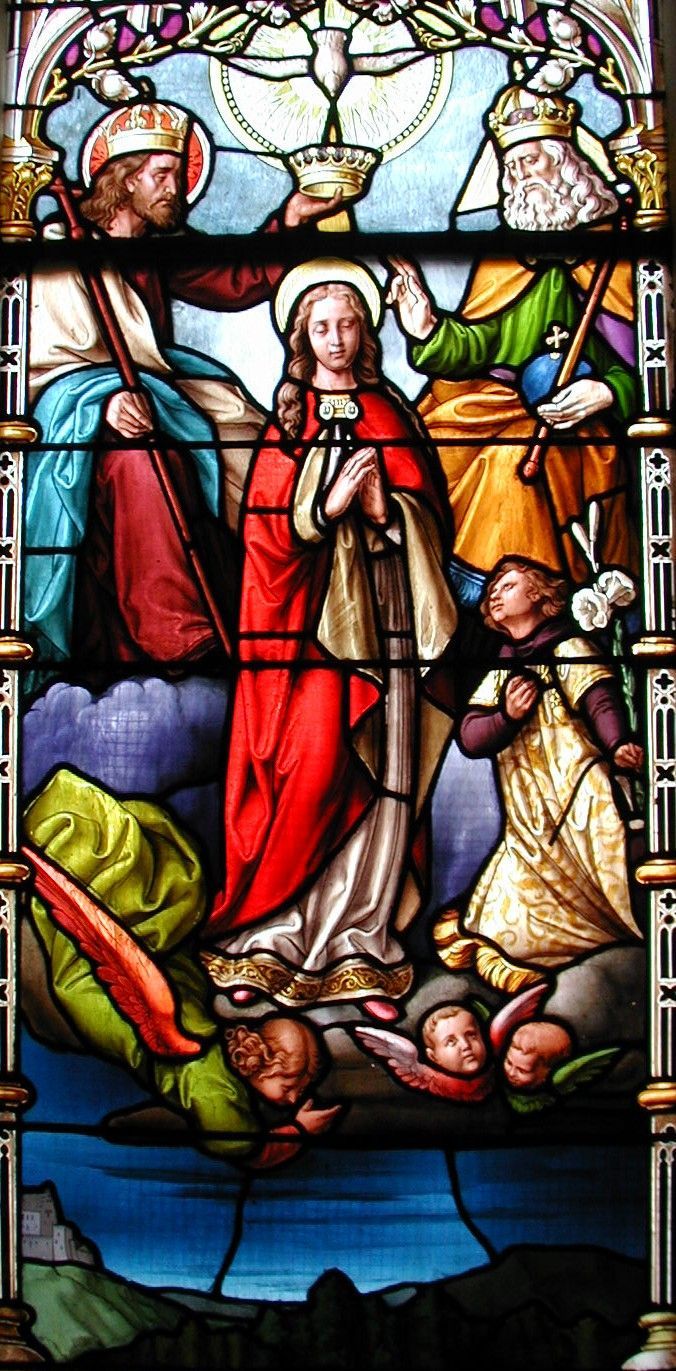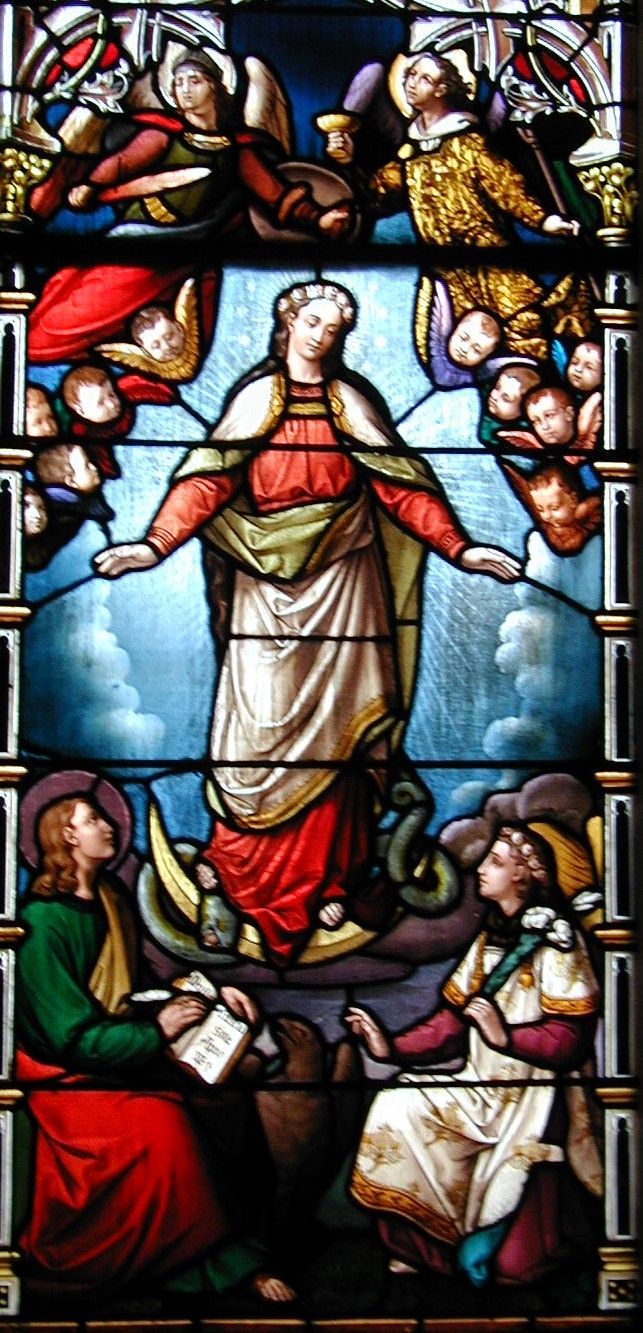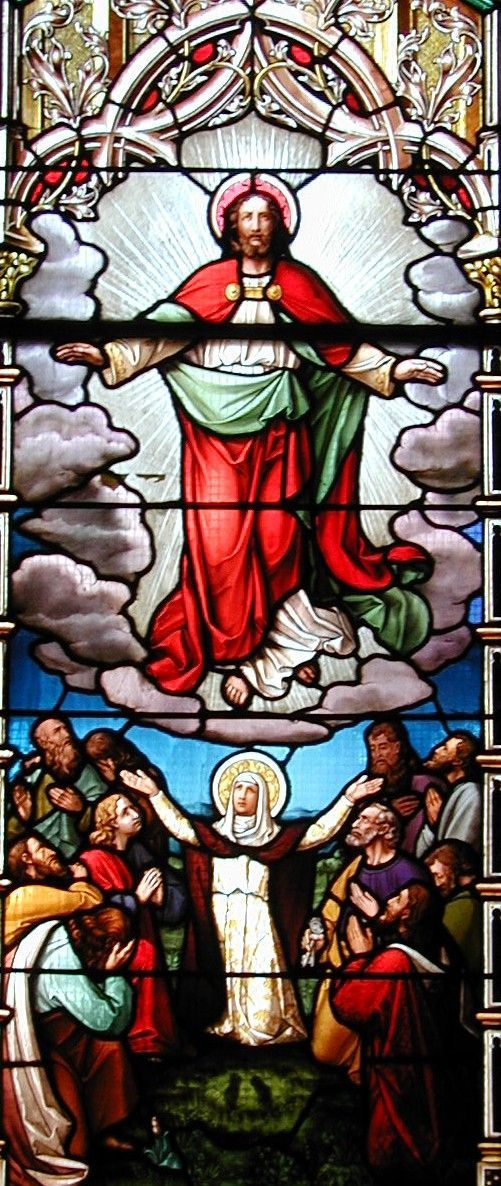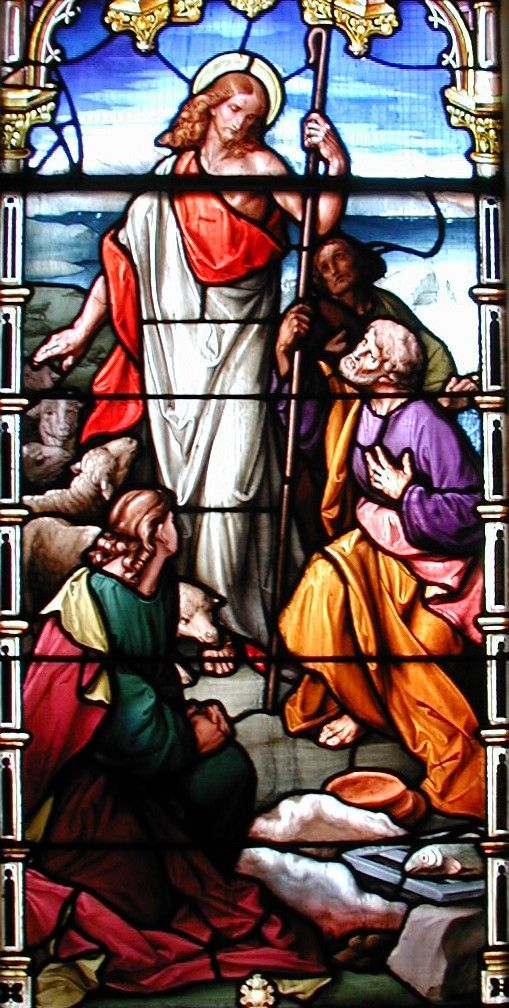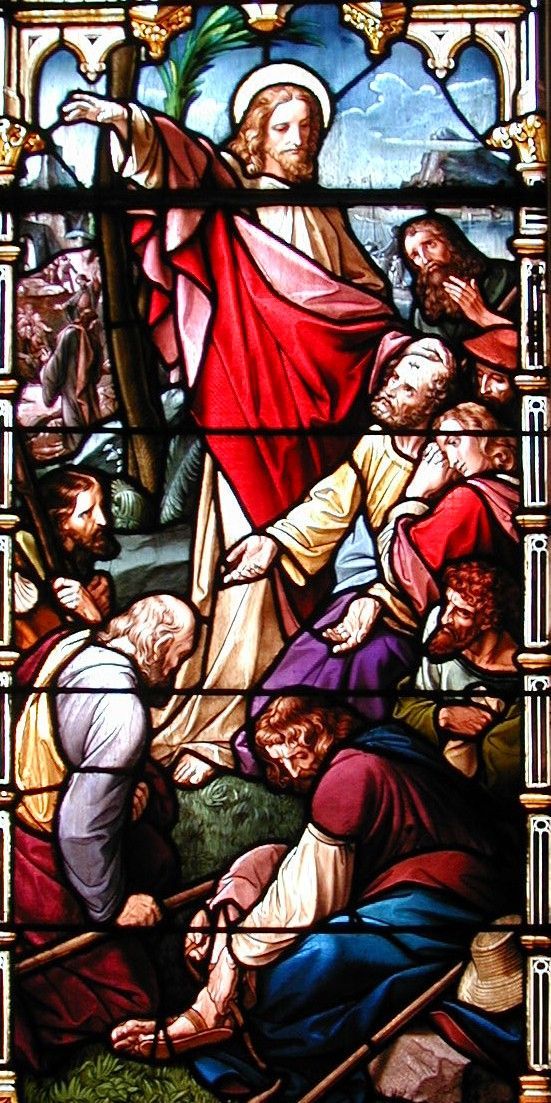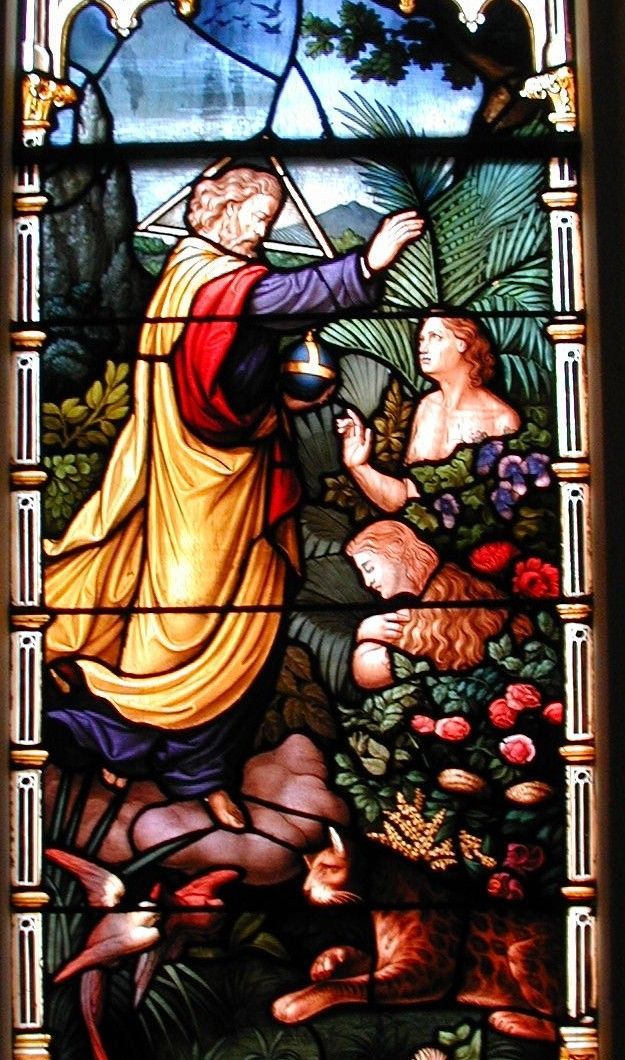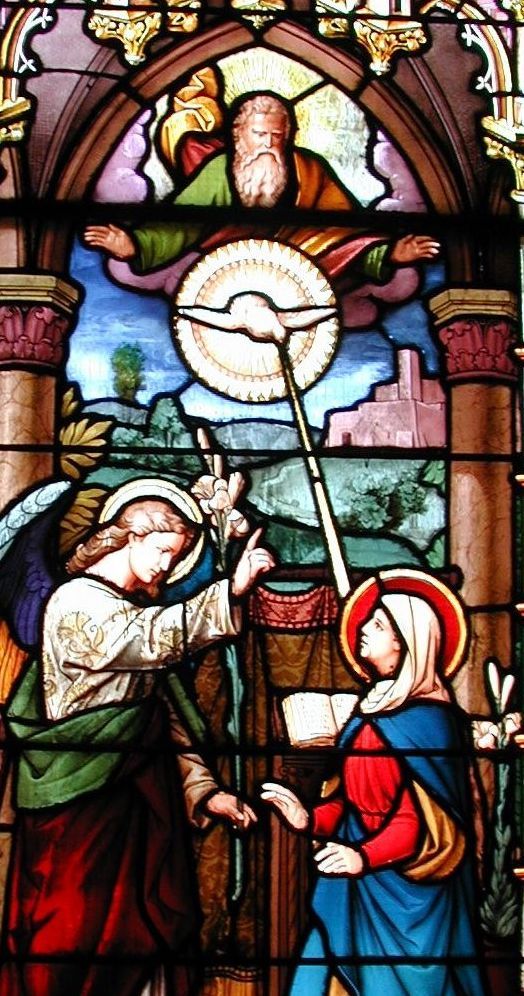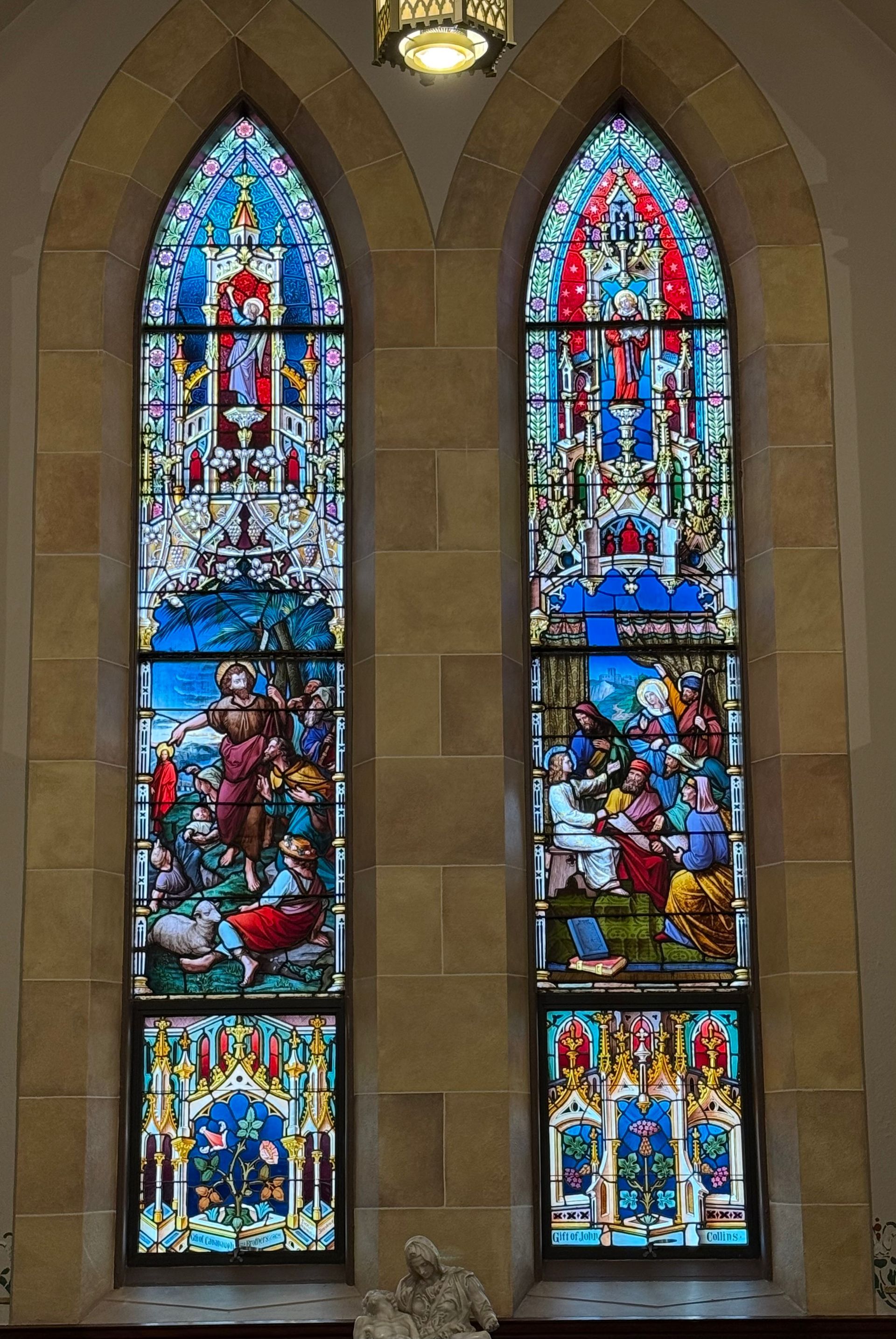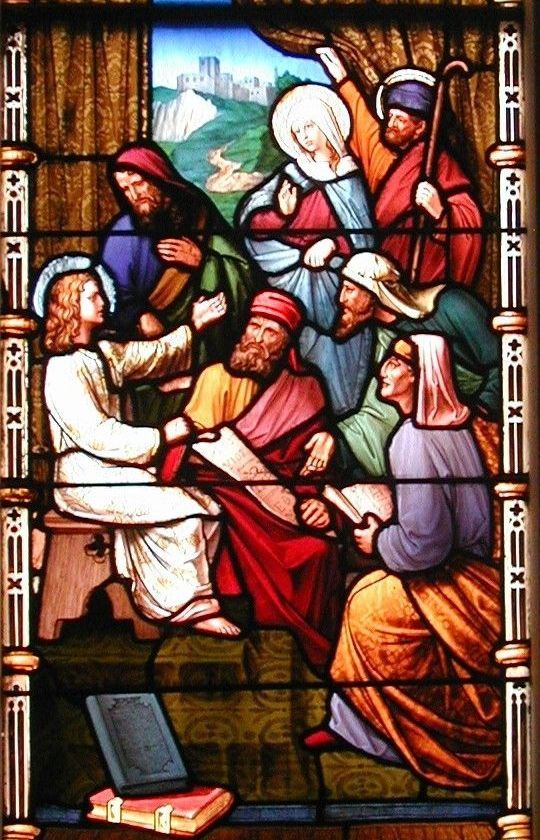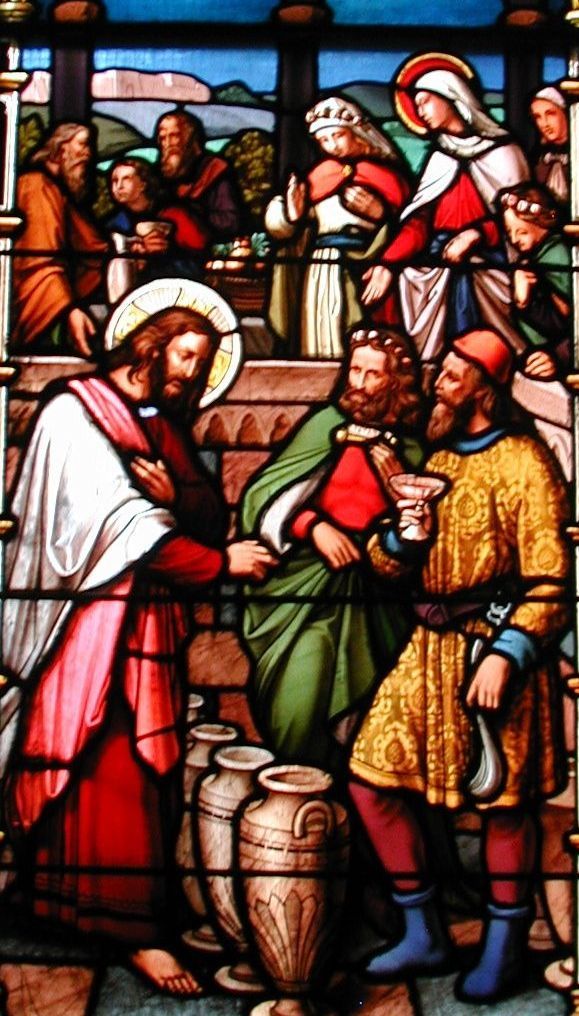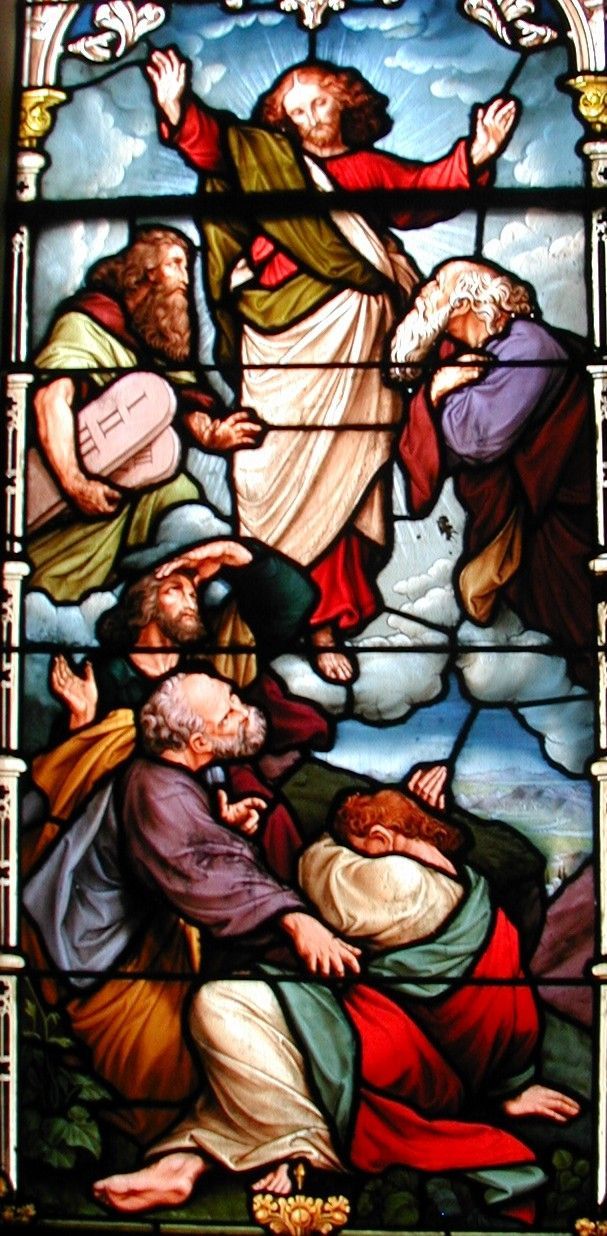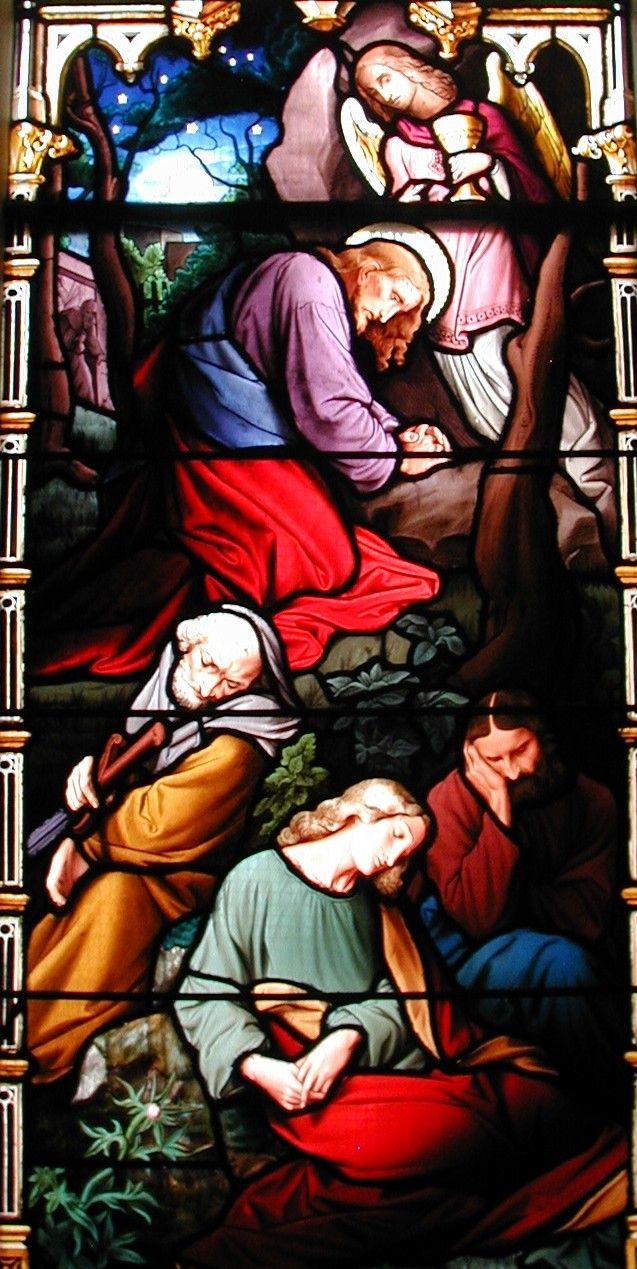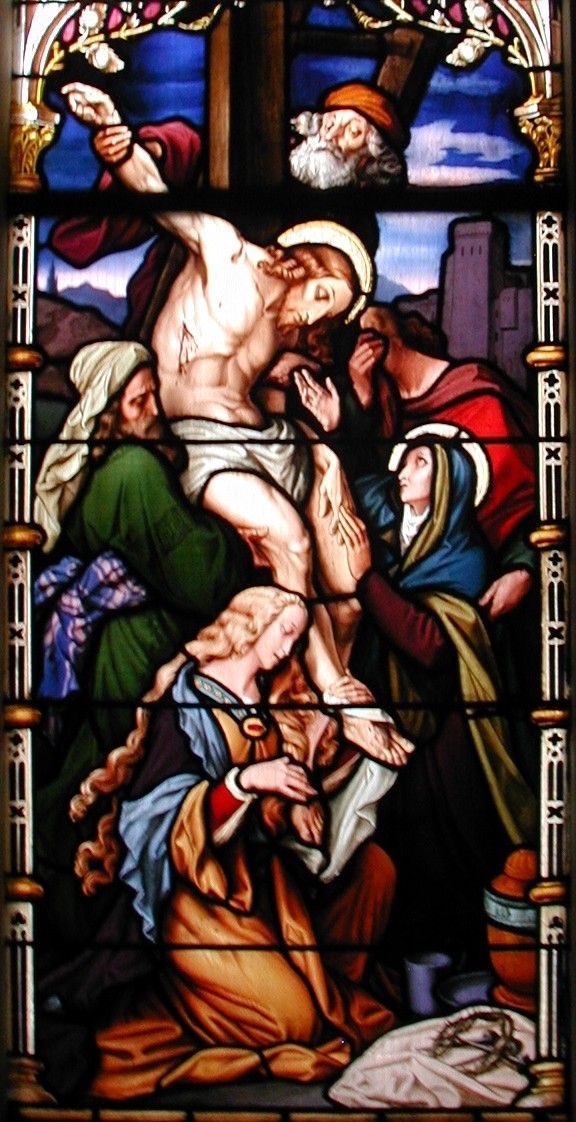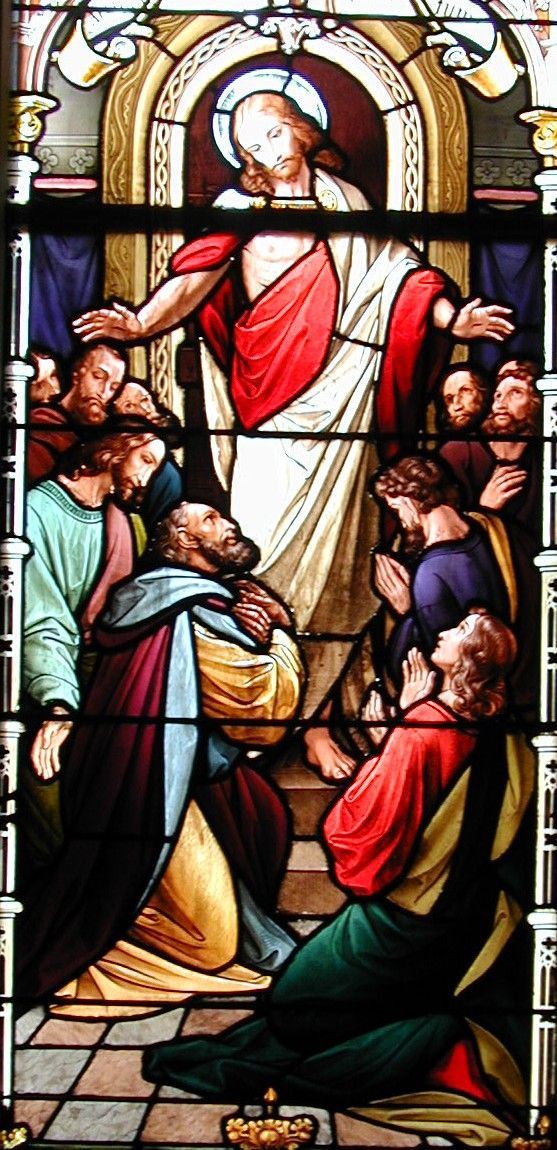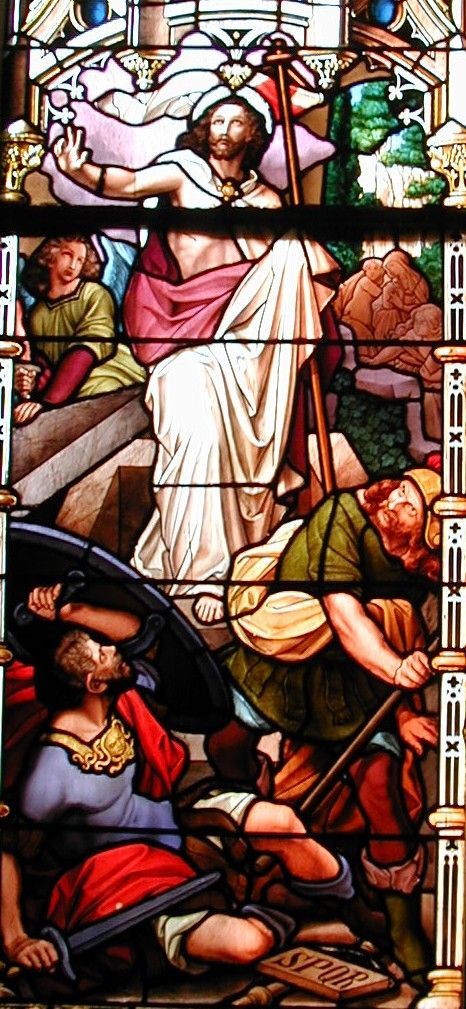Stained-glass windows in a church serve a double function. They add beauty to the building, but more importantly they are an aid to piety. By studying the subjects of the windows we should be moved to holy thoughts and resolutions. The windows of the Cathedral serve this double function in an admiral manner. They are exceptionally beautiful and with their many-faceted colors they are like jewls set in a precious crown. The submects of these windows speak to us on the mysteries of our religion, centering on the life of Christ and His Blessed Mother.
The windows, all donated, were installed for the consecration of the Cathedral in 1894. They were crafted in Innsbruck, Austria by the firm of Tiroler Glazmalerei. The subjects of the windows and their placement were all determined by Bishop Bradley.
The Sanctuary Windows
The central window is the central action of religion, the crucifixion of Christ. This particular window was on exhibition at the 1893 Columbian Exposition in Chicago. To the left of this window, is the institution of the Eucharist at the Last Supper. To the right of the Crucifixion we see depicted the sacrifice of Melchizedek, the Old Testament hight priest offering bread and wine to prefigure the Eucharist. The first window on the left presents Mary in teh custody of St. John who is offering her the Eucharist. This window was also on exhibition at the Columbian Exposition. the window opposite gives us St. Charles Borromeo administering the Eucharist to the dying people in Milan during the plague of 1586. The sanctuary windows, therefore, with their strong emphasis on the Eucharist in its instituion and in our daily life, form a fitting background for the Mass.
Cathedral Nave - The North Wall (Lowell St.)
All the windows in the body of the Cathedral portray different events from the Old and New Testaments. These windows have a common unity of design and decoration. The upper areas have gothic arches, angels singing and playing instruments, and a unity of coloring. The lower areas have flowers and other decorations from nature.
Beginning at the front entrance of the church and reading left to right towards the sancturary, the subjects of the windows are:
Cathedral Nave North Wall - Window 1
The Prodigal Son (left side)
The Sacred Heart of Jesus (right side)
The Prodigal Son
While he was yet at a distance his father saw him and had compassion, and ran and embraced him and kissed him. And the son said to him, ‘Father, I have sinned against heaven and before you; I am no longer worthy to be called your son.’ But the father said to his servants, ‘Bring quickly the best robe, and put it on him; and put a ring on his hand and shoes on his feet; and bring the fatted calf and kill it, and let us eat and make merry; for this my son was dead, and is alive again; he was lost and is found.’ (Lk 15:20-24)
The Most Sacred Heart of Jesus
The Sacred Heart of Jesus is a sign and symbol of Jesus’ burning love for each one of us. The Catechism of the Catholic Church 478 explains:
Jesus knew and loved us each and all during his life, his agony and his Passion, and gave himself up for each one of us: “The Son of God. . . loved me and gave himself for me.” (Galatians 2:20) He has loved us all with a human heart. For this reason, the Sacred Heart of Jesus, pierced by our sins and for our salvation (see John 19:34), “is quite rightly considered the chief sign and symbol of that. . . love with which the divine Redeemer continually loves the eternal Father and all human beings” without exception.
Cathedral Nave North Wall - Window 2
Jsus and the Children (left side)
The Preaching of Saint Patrick (right side)
Jesus and the Children
And people were bringing children to him that he might touch them, but the disciples rebuked them. When Jesus saw this he became indignant and said to them, “Let the children come to me; do not prevent them, for the kingdom of God belongs to such as these. Amen, I say to you, whoever does not accept the kingdom of God like a child* will not enter it.” Then he embraced them and blessed them, placing his hands on them. (Mark 10:13-16)
The Preaching of Saint Patrick
Saint Patrick is the secondary patron of the Diocese of Manchester. According to Patrick's autobiographical Confessio, when he was about sixteen, he was captured by Irish pirates from his home in Britain and taken as a slave to Ireland. He writes that he lived there for six years as an animal herder before escaping and returning to his family. After becoming a cleric, he returned to spread Christianity in northern and western Ireland. In later life, he served as a bishop, but little is known about where he worked. By the seventh century, he had already come to be revered as the patron saint of Ireland.
Cathedral Nave North Wall - Window 3
The Death of Saint Joseph (left side)
The Holy Family (right side)
The Death of Saint Joseph
There is tradition associated with St. Joseph, one not found in Sacred Scripture but a pious, probable and popular one: his death. St. Joseph is the patron of a happy death. He is typically represented on his death bed, Jesus on one side, Mary on the other.
Can anyone ask for a better death?
The Holy Family
Jesus, the Blessed Mother, and St. Joseph are the holiest of families, and therefore a model for all Christian families. They were holy because they placed God at the center of their family life, they loved and sacrificed for one another, and they radiated that love to others in the redemptive mission of the Word Incarnate.
Pope St. John Paul II said, “The Redeemer of the world chose the family as the place for his birth and growth, thereby sanctifying this fundamental institution of every society” (Angelus message, December 30, 2001)
Cathedral Nave North Wall - Window 4
Coronation of the Blessed Virgin (left)
The Immaculate Conception (right)
The Coronation of the Blessed Virgin
"And a great portent appeared in heaven, a woman clothed with the sun, with the moon under her feet, and on her head a crown of twelve stars" (Rev 12:1).
"Finally the Immaculate Virgin, preserved free from all stain of original sin, when the course of her earthly life was finished, was taken up body and soul into heavenly glory, and exalted by the Lord as Queen over all things, so that she might be the more fully conformed to her Son, the Lord of lords and conqueror of sin and death" (CCC, 966).
The Immaculate Conception
In the Constitution Ineffabilis Deus of 8 December, 1854, Pius IX pronounced and defined that the Blessed Virgin Mary "in the first instance of her conception, by a singular privilege and grace granted by God, in view of the merits of Jesus Christ, the Saviour of the human race, was preserved exempt from all stain of original sin."
The term conception does not mean the active or generative conception by her parents. Her body was formed in the womb of the mother, and the father had the usual share in its formation. The question does not concern the immaculateness of the generative activity of her parents. Neither does it concern the passive conception absolutely and simply (conceptio seminis carnis, inchoata), which, according to the order of nature, precedes the infusion of the rational soul. The person is truly conceived when the soul is created and infused into the body. Mary was preserved exempt from all stain of original sin at the first moment of her animation, and sanctifying grace was given to her before sin could have taken effect in her soul.
Cathedral Nave North Wall - Window 5
The Descent of the Holy Spirit (left)
The Ascension of Christ (right)
The Descent of the Holy Spirit
"When the day of Pentecost had come, they were all together in one place. And suddenly a sound came from heaven like the rush of a mighty wind, and it filled all the house where they were sitting. And there appeared to them tongues as of fire, distributed and resting on each one of them. And they were all filled with the Holy Spirit and began to speak in other tongues, as the Spirit gave them utterance" (Acts 2:1-4).
"'Holy Spirit' is the proper name of the one whom we adore and glorify with the Father and the Son. The Church has received this name from the Lord and professes it in the Baptism of her new children" (CCC, 691).
The Ascension of Christ
In the first book, Theophilus, I dealt with all that Jesus did and taught until the day he was taken up, after giving instructions through the Holy Spirit to the apostles whom he had chosen. He presented himself alive to them by many proofs after he had suffered, appearing to them during forty days and speaking about the kingdom of God.
While meeting with the them, he enjoined them not to depart from Jerusalem, but to wait for “the promise of the Father about which you have heard me speak; for John baptized with water, but in a few days you will be baptized with the Holy Spirit.”
When they had gathered together they asked him, “Lord, are you at this time going to restore the kingdom to Israel?” He answered them, “It is not for you to know the times or seasons that the Father has established by his own authority. But you will receive power when the Holy Spirit comes upon you, and you will be my witnesses in Jerusalem, throughout Judea and Samaria, and to the ends of the earth.” When he had said this, as they were looking on, he was lifted up, and a cloud took him from their sight. While they were looking intently at the sky as he was going, suddenly two men dressed in white garments stood beside them. They said, “Men of Galilee, why are you standing there looking at the sky? This Jesus who has been taken up from you into heaven will return in the same way as you have seen him going into heaven.” ~ Acts 1: 1-11
Cathedral Nave North Wall - Window 6
Christ's Commision to Peter (left)
Christ's Commission to the Apostles (right)
Christ's Commission to Peter
Bishop Bradley's window
When they had finished breakfast, Jesus said to Simon Peter, “Simon, son of John, do you love me more than these?” He said to him, “Yes, Lord, you know that I love you.” He said to him, “Feed my lambs.” He then said to him a second time, “Simon, son of John, do you love me?” He said to him, “Yes, Lord, you know that I love you.” He said to him, “Tend my sheep.” He said to him the third time, “Simon, son of John, do you love me?” Peter was distressed that he had said to him a third time, “Do you love me?” and he said to him, “Lord, you know everything; you know that I love you.” [Jesus] said to him, “Feed my sheep. Amen, amen, I say to you,j when you were younger, you used to dress yourself and go where you wanted; but when you grow old, you will stretch out your hands, and someone else will dress you and lead you where you do not want to go.” He said this signifying by what kind of death he would glorify God. And when he had said this, he said to him, “Follow me.” ~ John 21:15-19
Christ's Commission to the Apostles
This window memoralizes Fr. O'Brien, the first pastor of St Joseph Church.
The eleven disciples went to Galilee, to the mountain to which Jesus had ordered them. When they saw him, they worshiped, but they doubted. Then Jesus approached and said to them, “All power in heaven and on earth has been given to me. Go, therefore, and make disciples of all nations, baptizing them in the name of the Father, and of the Son, and of the Holy Spirit, teaching them to observe all that I have commanded you. And behold, I am with you always, until the end of the age.” ~ Matt 28:16-20
Cathedral Nave - South Wall (Bishop Bradley Lane)
These windows give a continuous history of religion from the creation to the Resurrection. They should be read from the church entrance towards the sanctuary. This order was established by Bishop Bradley. The windows are:
Cathedral Nave South Wall - Window 1
The Creation of the World (right)
Moses Giving the Law (left)
The Creation of the World
In the beginning, when God created the heavens and the earth. Then God said: Let us make human beings in our image, after our likeness. Let them have dominion over the fish of the sea, the birds of the air, the tame animals, all the wild animals, and all the creatures that crawl on the earth. God created mankind in his image; in the image of God he created them; male and female he created them. God blessed them and God said to them: Be fertile and multiply; fill the earth and subdue it. Have dominion over the fish of the sea, the birds of the air, and all the living things that crawl on the earth. (Genesis 1: 1, 26-28)
Moses Giving the Law to the People
Then the LORD said to Moses: Write down these words, for in accordance with these words I have made a covenant with you and with Israel. So Moses was there with the LORD for forty days and forty nights,l without eating any food or drinking any water, and he wrote on the tablets the words of the covenant, the ten words. As Moses came down from Mount Sinai with the two tablets of the covenant in his hands, he did not know that the skin of his face had become radiant while he spoke with the LORD. When Aaron, then, and the other Israelites saw Moses and noticed how radiant the skin of his face had become, they were afraid to come near him. Only after Moses called to them did Aaron and all the leaders of the community come back to him. Moses then spoke to them. Later, all the Israelites came up to him, and he enjoined on them all that the LORD had told him on Mount Sinai. (Exodus 34: 27-32)
The Cathedral Nave South Wall - Window 2
The Annunciation (right)
The Magi at Bethlehem (left)
The Annunciation
In the sixth month, the angel Gabriel was sent from God to a town of Galilee called Nazareth,
to a virgin betrothed to a man named Joseph, of the house of David, and the virgin’s name was Mary. And coming to her, he said, “Hail, favored one! The Lord is with you.”But she was greatly troubled at what was said and pondered what sort of greeting this might be.
Then the angel said to her, “Do not be afraid, Mary, for you have found favor with God. Behold, you will conceive in your womb and bear a son, and you shall name him Jesus. He will be great and will be called Son of the Most High, and the Lord God will give him the throne of David his father, and he will rule over the house of Jacob forever, and of his kingdom there will be no end.” But Mary said to the angel, “How can this be, since I have no relations with a man?”And the angel said to her in reply, “The holy Spirit will come upon you, and the power of the Most High will overshadow you. Therefore the child to be born will be called holy, the Son of God. And behold, Elizabeth, your relative, has also conceived a son in her old age, and this is the sixth month for her who was called barren; for nothing will be impossible for God.”Mary said, “Behold, I am the handmaid of the Lord. May it be done to me according to your word.” Then the angel departed from her. (Luke 1:26-38)
The Magi at Bethlehem
When Jesus was born in Bethlehem of Judea, in the days of King Herod, behold, magi from the east arrived in Jerusalem, saying, “Where is the newborn king of the Jews? We saw his star at its rising and have come to do him homage.” When King Herod heard this, he was greatly troubled, and all Jerusalem with him. Assembling all the chief priests and the scribes of the people, he inquired of them where the Messiah was to be born. They said to him, “In Bethlehem of Judea, for thus it has been written through the prophet: ‘And you, Bethlehem, land of Judah, are by no means least among the rulers of Judah; since from you shall come a ruler, who is to shepherd my people Israel.’”
Then Herod called the magi secretly and ascertained from them the time of the star’s appearance. He sent them to Bethlehem and said, “Go and search diligently for the child. When you have found him, bring me word, that I too may go and do him homage.” After their audience with the king they set out. And behold, the star that they had seen at its rising preceded them, until it came and stopped over the place where the child was. They were overjoyed at seeing the star,
and on entering the house they saw the child with Mary his mother. They prostrated themselves and did him homage. Then they opened their treasures and offered him gifts of gold, frankincense, and myrrh. And having been warned in a dream not to return to Herod, they departed for their country by another way. (Matthew 2:1-12)
The Cathedral Nave South Wall - Window 3
Chist Teaching in the Temple (right)
The Baptism of Jesus (left)
Christ Teaching in the Temple
Now his parents went to Jerusalem every year at the feast of the Passover. And when he was twelve years old, they went up according to custom; and when the feast was ended, as they were returning, the boy Jesus stayed behind in Jerusalem. His parents did not know it, but supposing him to be in the company they went a day’s journey, and they sought him among their kinsfolk and acquaintances; and when they did not find him, they returned to Jerusalem, seeking him. After three days they found him in the temple, sitting among the teachers, listening to them and asking them questions; and all who heard him were amazed at his understanding and his answers. And when they saw him they were astonished; and his mother said to him, “Son, why have you treated us so? Behold, your father and I have been looking for you anxiously.” And he said to them, “How is it that you sought me? Did you not know that I must be in my Father’s house?” And they did not understand the saying which he spoke to them. And he went down with them and came to Nazareth, and was obedient to them; and his mother kept all these things in her heart. And Jesus increased in wisdom and in stature, and in favor with God and man. (Luke 2:41-52)
The Baptism of Christ by St. John the Baptist
And this is the testimony of John, when the Jews sent priests and Levites from Jerusalem to ask him, “Who are you?” He confessed, he did not deny, but confessed, “I am not the Christ.” And they asked him, “What then? Are you Eli′jah?” He said, “I am not.” “Are you the prophet?” And he answered, “No.” They said to him then, “Who are you? Let us have an answer for those who sent us. What do you say about yourself?” He said, “I am the voice of one crying in the wilderness, ‘Make straight the way of the Lord,’ as the prophet Isaiah said.”
Now they had been sent from the Pharisees. 25 They asked him, “Then why are you baptizing, if you are neither the Christ, nor Eli′jah, nor the prophet?” John answered them, “I baptize with water; but among you stands one whom you do not know, even he who comes after me, the thong of whose sandal I am not worthy to untie.” This took place in Bethany beyond the Jordan, where John was baptizing.
The next day he saw Jesus coming toward him, and said, “Behold, the Lamb of God, who takes away the sin of the world! This is he of whom I said, ‘After me comes a man who ranks before me, for he was before me.’ I myself did not know him; but for this I came baptizing with water, that he might be revealed to Israel.” And John bore witness, “I saw the Spirit descend as a dove from heaven, and it remained on him. I myself did not know him; but he who sent me to baptize with water said to me, ‘He on whom you see the Spirit descend and remain, this is he who baptizes with the Holy Spirit.’ And I have seen and have borne witness that this is the Son of God.” (John 1:19-34)
The Cathedral Nave South Wall - Window 4
The Wedding at Cana (right)
The Transfiguration (left)
The Wedding at Cana
On the third day there was a marriage at Cana in Galilee, and the mother of Jesus was there; Jesus also was invited to the marriage, with his disciples. When the wine gave out, the mother of Jesus said to him, “They have no wine.” And Jesus said to her, “O woman, what have you to do with me? My hour has not yet come.” His mother said to the servants, “Do whatever he tells you.” Now six stone jars were standing there, for the Jewish rites of purification, each holding twenty or thirty gallons. Jesus said to them, “Fill the jars with water.” And they filled them up to the brim. He said to them, “Now draw some out, and take it to the steward of the feast.” So they took it. When the steward of the feast tasted the water now become wine, and did not know where it came from (though the servants who had drawn the water knew), the steward of the feast called the bridegroom and said to him, “Every man serves the good wine first; and when men have drunk freely, then the poor wine; but you have kept the good wine until now.” This, the first of his signs, Jesus did at Cana in Galilee, and manifested his glory; and his disciples believed in him. (John 2:1-11)
The Transfiguration
And after six days Jesus took with him Peter and James and John his brother, and led them up a high mountain apart. And he was transfigured before them, and his face shone like the sun, and his garments became white as light. And behold, there appeared to them Moses and Eli′jah, talking with him. And Peter said to Jesus, “Lord, it is well that we are here; if you wish, I will make three booths here, one for you and one for Moses and one for Eli′jah.” He was still speaking, when lo, a bright cloud overshadowed them, and a voice from the cloud said, “This is my beloved Son, with whom I am well pleased; listen to him.” When the disciples heard this, they fell on their faces, and were filled with awe. But Jesus came and touched them, saying, “Rise, and have no fear.” And when they lifted up their eyes, they saw no one but Jesus only.
And as they were coming down the mountain, Jesus commanded them, “Tell no one the vision, until the Son of man is raised from the dead.” And the disciples asked him, “Then why do the scribes say that first Eli′jah must come?” He replied, “Eli′jah does come, and he is to restore all things; but I tell you that Eli′jah has already come, and they did not know him, but did to him whatever they pleased. So also the Son of man will suffer at their hands.” Then the disciples understood that he was speaking to them of John the Baptist. (Matthew 17:1-13)
The Cathedral Nave South Wall - Window 5
Jesus Prays in Gethsemane (right)
The Descent from the Cross (left)
Jesus Prays in Gethsemane
And they went to a place which was called Gethsem′ane; and he said to his disciples, “Sit here, while I pray.” And he took with him Peter and James and John, and began to be greatly distressed and troubled. And he said to them, “My soul is very sorrowful, even to death; remain here, and watch.” And going a little farther, he fell on the ground and prayed that, if it were possible, the hour might pass from him. And he said, “Abba, Father, all things are possible to thee; remove this cup from me; yet not what I will, but what thou wilt.” And he came and found them sleeping, and he said to Peter, “Simon, are you asleep? Could you not watch one hour? Watch and pray that you may not enter into temptation; the spirit indeed is willing, but the flesh is weak.” And again he went away and prayed, saying the same words. And again he came and found them sleeping, for their eyes were very heavy; and they did not know what to answer him. And he came the third time, and said to them, “Are you still sleeping and taking your rest? It is enough; the hour has come; the Son of man is betrayed into the hands of sinners. Rise, let us be going; see, my betrayer is at hand.” (Mark 14:32-42)
The Descent from the Cross
After this Joseph of Arimathe′a, who was a disciple of Jesus, but secretly, for fear of the Jews, asked Pilate that he might take away the body of Jesus, and Pilate gave him leave. So he came and took away his body. Nicode′mus also, who had at first come to him by night, came bringing a mixture of myrrh and aloes, about a hundred pounds’ weight. They took the body of Jesus, and bound it in linen cloths with the spices, as is the burial custom of the Jews. Now in the place where he was crucified there was a garden, and in the garden a new tomb where no one had ever been laid. So because of the Jewish day of Preparation, as the tomb was close at hand, they laid Jesus there. (John 19:38-42)
The Cathedral Nave South Wall - Window 6
The Resurrection (right)
Christ Appearing to the Apostles (left)
The Resurection
Now on the first day of the week Mary Mag′dalene came to the tomb early, while it was still dark, and saw that the stone had been taken away from the tomb. So she ran, and went to Simon Peter and the other disciple, the one whom Jesus loved, and said to them, “They have taken the Lord out of the tomb, and we do not know where they have laid him.” Peter then came out with the other disciple, and they went toward the tomb. They both ran, but the other disciple outran Peter and reached the tomb first; and stooping to look in, he saw the linen cloths lying there, but he did not go in. Then Simon Peter came, following him, and went into the tomb; he saw the linen cloths lying, and the napkin, which had been on his head, not lying with the linen cloths but rolled up in a place by itself. Then the other disciple, who reached the tomb first, also went in, and he saw and believed; for as yet they did not know the scripture, that he must rise from the dead. Then the disciples went back to their homes. (John 20:1-10)
Christ Appearing to the Apostles
On the evening of that day, the first day of the week, the doors being shut where the disciples were, for fear of the Jews, Jesus came and stood among them and said to them, “Peace be with you.” When he had said this, he showed them his hands and his side. Then the disciples were glad when they saw the Lord. Jesus said to them again, “Peace be with you. As the Father has sent me, even so I send you.” And when he had said this, he breathed on them, and said to them, “Receive the Holy Spirit. If you forgive the sins of any, they are forgiven; if you retain the sins of any, they are retained.” (John 20:19-23)
Choir Windows
The windows in the organ loft are appropriate to the setting. There are angels singing and playing musical instruments. Depicted also are an organ, a harp, a trumpet, and other instruments.
